With what encomiums does the Orthodox Church not praise the holy Great-Martyr George, “the greatest of the great martyrs”, “the chief of the martyrs”, “he who is known everywhere by his miracles”, “he who is swift to help”, etc. These sublime names are the evidence of countless miracles that have occurred and still occur throughout Christendom thanks to St. George’s intercessions before God. Below we offer our readers a small selection of his miracles that took place in the relatively recent past in different parts of the world.
A novice
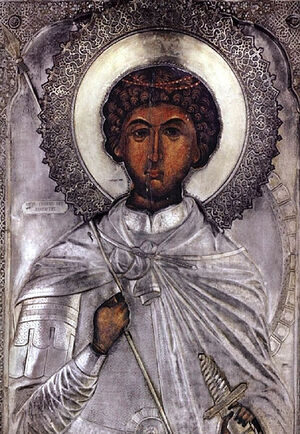 Icon of St. George the Revealed If Holy Mount Athos is regarded as the garden of the Most Holy Theotokos, then St. George is called the guardian of this garden. It is to St. George that the katholikons (cathedral churches) of the Monasteries of Zographou and Xenophontos are dedicated, and numerous chapels and small monastic structures—kathismata and cells—named after the holy great-martyr, are scattered throughout Mt. Athos.
Icon of St. George the Revealed If Holy Mount Athos is regarded as the garden of the Most Holy Theotokos, then St. George is called the guardian of this garden. It is to St. George that the katholikons (cathedral churches) of the Monasteries of Zographou and Xenophontos are dedicated, and numerous chapels and small monastic structures—kathismata and cells—named after the holy great-martyr, are scattered throughout Mt. Athos.
One of these cells, which was rumored to contain riches and in which two old monks struggled, was under the jurisdiction of Pantocrator Monastery.
One night, strangers knocked on the cell’s door. A voice from inside asked who was there and what they wanted at night. The men replied that they were pilgrims and asked for lodging for the night. A young novice opened the door. There were three men in front of him who wanted to see the elders. The novice took them to the guest room and asked them to wait.
The strangers sat down and waited. Dead silence reigned in the cell. Two whole hours passed in waiting! Finally, they wanted to rise from their seats, but to no avail: it was as if someone had tied them hand and foot with invisible bonds. Screams rang out in the cell. The poor elders woke up and rushed in horror to the guest room, only to find these strangers, screaming wildly.
“Who are you? What do you need? How did you get inside?” the monks asked them in bewilderment.
“Your young novice let us in!”
“A novice? We do not have any novices!”
Then the “pilgrims” had to reveal the truth: it turned out that one of them was the infamous thief Stamatis, who would commit robberies all over Halkidiki peninsula and Mt. Athos. Together with two mates, Stamatis had decided to rob their cell, knowing that two infirm old monks lived there. Pretending to be pilgrims, they intended to get into the cell, kill the elders and commit a robbery. And everything would have gone according to their scheme if not for this novice! Who was he? How had he gotten into the cell?
The elders realized that it must have been a miracle. They ran to the church and brought the robbers an icon of St. George. The thieves were horrified when they saw the “novice” depicted on the icon. Yes, it was he who had opened the door for them! When they tried to kiss the icon, they were freed from the invisible bonds.
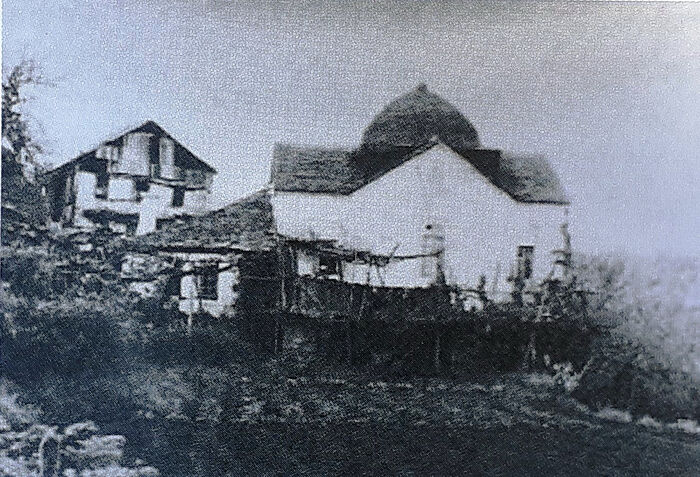 The cell of St. George the Revealed
The cell of St. George the Revealed
Since then, the cell has been called “the cell of St. George the Revealed”, and the icon is now kept in the katholikon of Pantocrator Monastery. The miracle made such an impression on Stamatis that he gave up being a bandit and, being the first to settle in the most uninhabited part of Mt. Athos—in Karoulia—he built himself a hut with a small church of St. George. He reposed in the Lord as a holy ascetic.
The protector of plants
In Western Armenia (now in Turkey), in the Akn region, the famous center of veneration of St. George was the village of Vank, residents of which, mostly Orthodox Armenians, since ancient times regarded St. George as the patron of their village. The old village church, dedicated to the holy Great-Martyr George, was situated in the woods, on the banks of the biblical River Euphrates. As church territory, this grove was considered St. George’s reserve, and those who encroached on it were punished severely.
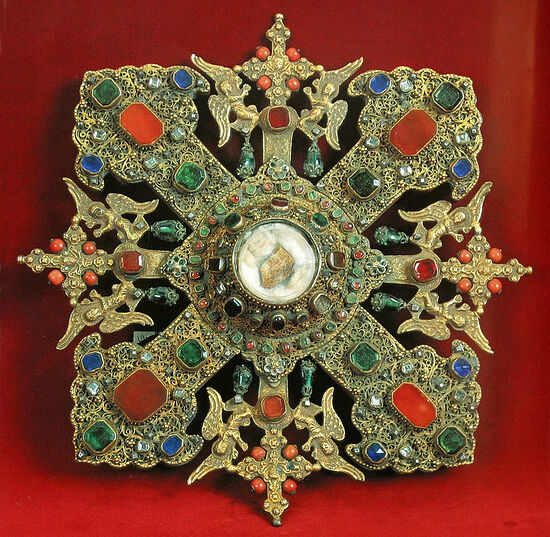 Reliquary cross with a particle of St. George’s head (Treasury of the Mother See of Holy Etchmiadzin, Armenia)
Reliquary cross with a particle of St. George’s head (Treasury of the Mother See of Holy Etchmiadzin, Armenia)
One day, a Turk, disregarding the holiness of the place, went to the woods to stock up on firewood. Having cut down a tree and heaped firewood on to his shoulders, and satisfied with the work done, he was on his way home when he suddenly saw in front of him a rider on a gray horse and in a scarlet cloak. The horseman drew his sword and, holding it over the blasphemer’s head, threatened him:
“The next time you enter the woods to chop down trees I will put you to the sword! If you wish you can fell dead trees, but don’t you dare touch green ones!”
After that the Turk ran into the village in horror, telling the Christians about the miracle and calling on everyone to stay away from the grove. However, not everyone believed him. One Turkish woman went into the same grove and cut down a half-dried tree. When it fell, the woman went up to it to move it, but no sooner had she touched the tree than she became motionless. The one who had bound her with invisible bonds—St. George on horseback—was standing in front of her. The Turkish woman remained in this position the whole day, wailing and begging for help. Towards late evening her young son, frightened by his mother’s long absence, went into the woods in search of her and found her in a miserable state. The mother, sobbing, told her son about what had happened and promised to never again enter the woods sacred to Christians. Once she uttered the promise, the invisible chains fell off and she was able to straighten up.
An unknown rider
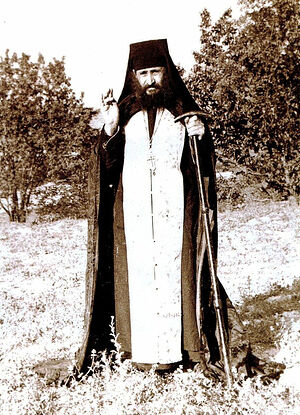 St. George (Karslidis) the New Confessor of Drama On Byzantine icons St. George is often depicted as a rider, on whose horse you can see a young boy, whom St. George delivered from the horrors of captivity and safely returned to his parents’ house. For this reason the Church honors St. George as the liberator of captives. But miracles of St. George moving people from place to place are known in our era as well. One illustration of this is the miracle that happened to the holy New Confessor George (1901–1959), a remarkable ascetic of the twentieth century.
St. George (Karslidis) the New Confessor of Drama On Byzantine icons St. George is often depicted as a rider, on whose horse you can see a young boy, whom St. George delivered from the horrors of captivity and safely returned to his parents’ house. For this reason the Church honors St. George as the liberator of captives. But miracles of St. George moving people from place to place are known in our era as well. One illustration of this is the miracle that happened to the holy New Confessor George (1901–1959), a remarkable ascetic of the twentieth century.
Born Athanasius Karslidis, he was born in Argyroupolis, Pontos. Having lost his parents early, the future saint was brought up by his God-loving grandmother Anna, after whose demise the seven-year-old boy, together with his grandfather, moved to the city of Karin (Erzurum). After his grandfather’s death Athanasius decided to move to the Caucasus. Alone, he crossed difficult, snow-covered mountain roads, suffering from hunger and cold. Once he was even covered with snow, so passers-by barely rescued him. Athanasius was on the verge of despair, but continued with tears to beg for God’s help. One day, as he continued on his way, he met a rider who took the boy on his horse and began to lovingly explain to him where he would be taken and what exactly he should do next. Despite the great distance, the rider took Athanasius to a city unfamiliar to him: it was the magnificent Tiflis (now Tbilisi)—the capital of the Caucasus. Athanasius did as he was told, and his life path led him to New Athos Monastery.
Subsequently, when he was ordained to the priesthood, he took the name George, in honor of the saint who had rescued him and set him on the path of God.
St. George who was late for the Liturgy
Around 1903, an Orthodox Arab named Khalil Abufarha, the churchwarden of the cave church in the Syrian village of Betshakhur, went to church to light the icon lamps and prepare it for Matins. Approaching the church, he heard unfamiliar voices; to his surprise, a service was already in progress at the church. What was his amazement when, having stepped inside, he became an eyewitness of the Divine Liturgy being celebrated by the angels and the Most Holy Theotokos Herself! Khalil froze. Suddenly, the clatter of a horse’s hooves was heard outside, and a young warrior entered the cave church. Then he hurriedly went to the Queen of Heaven.
“Where have you been, St. George?” She asked him loudly. “Why are you late?”
“O Sovereign Lady, the Most Holy Mother of God, a boat was sinking in the open sea, and I ran to save people who began to invoke my name.”
Having said this, St. George took off his wet cloak, splashing Khalil’s face and clothes. At the end of the Liturgy Khalil was vouchsafed to receive antidoron from the hands of the Most Pure Virgin Herself. After this, the Mother of God, St. George, and the angels disappeared. A little later, when the village priest and the parishioners entered the church, they found Khalil, still wet from the splashes from St. George’s cloak and carefully holding the antidoron received from the Most Holy Theotokos in his hand.
Deliverance from the death sentence
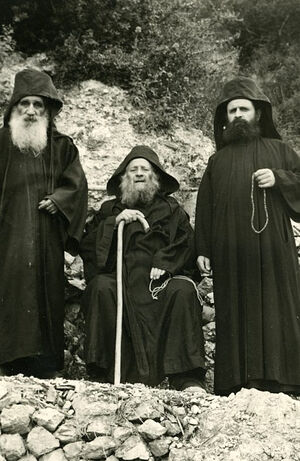 FR. Charalambos (Galanopoulos) to the left of St. Joseph the Hesychast One of the disciples and companions of St. Joseph the Hesychast (1897–1959) was Fr. Charalambos (Galanopoulos; 1910–2001), Abbot of the Athonite Dionysiou Monastery. A Pontic Greek by origin, he was born in 1910 in Russia and as a ten-year-old boy moved with his family to Greece, where they settled down in northern Greece, in the village of Arkadiko near Drama. The young man had great success in his studies; however, he quit his studies to provide for his family.
FR. Charalambos (Galanopoulos) to the left of St. Joseph the Hesychast One of the disciples and companions of St. Joseph the Hesychast (1897–1959) was Fr. Charalambos (Galanopoulos; 1910–2001), Abbot of the Athonite Dionysiou Monastery. A Pontic Greek by origin, he was born in 1910 in Russia and as a ten-year-old boy moved with his family to Greece, where they settled down in northern Greece, in the village of Arkadiko near Drama. The young man had great success in his studies; however, he quit his studies to provide for his family.
In 1941, during the German occupation of Hellas, the Bulgarian commissars arrested Charalambos along with his fellow villagers and threw him into a concentration camp. A week later, something that no one had expected happened: the prisoners were sentenced to death. Charalambos knelt down and prayed tearfully:
“Holy Great-Martyr George, valiant warrior of Christ, save us! and I promise to devote my entire life to God!”
“Once I finished the prayer,” the elder related later, “I heard a noise above us—the clatter of a horse’s hooves. I lifted my eyes: a horse was galloping in the air over us, but I did not see any rider. But everything was clear! It must have been Saint George, but I was unworthy of seeing him. Although I saw only a horse, it meant that he had heard us!”
Early in the morning the executioners entered the cell, ready to carry out the sentence. Seconds later, the doors of the cell opened wide and a young man of athletic build entered and shouted furiously:
“Stop right now, villains! Release the innocent people and let them return to their homes! Otherwise I will shoot you all!”
Terrified, the executioners immediately left the cell. The young man vanished too. Of course, no one doubted that it had been Great-Martyr George. After a short time, the prisoners were granted amnesty in connection with the birth of the heir to the Bulgarian throne.
Nine years after this miracle, Charalambos Galanopoulos abandoned the world and became a monk on Mt. Athos in fulfillment of his vow to God and St. George.
Opening of the church
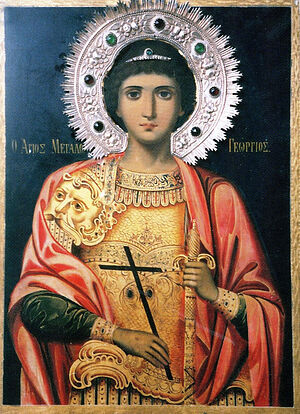 St. George’s icon from Xenophontos Monastery on Mt. Athos In the Khrushchev era (1953–1964) the exiled Archimandrite Seraphim (Sutorikhin; 1901–1979) served at the Samarkand (in Uzbekistan) Church of St. George the Victorious. Repressed and after serving ten years in the camps, Fr. Seraphim, already old and weak, became a beacon of light for many believers, especially the young. The authorities could not forgive him for such activities. With the help of provocateurs from the KGB, they ensured that St. George’s Church was closed, so the faithful had to worship secretly under cover of night. Two years later it was decided to convert the church into a kindergarten.
St. George’s icon from Xenophontos Monastery on Mt. Athos In the Khrushchev era (1953–1964) the exiled Archimandrite Seraphim (Sutorikhin; 1901–1979) served at the Samarkand (in Uzbekistan) Church of St. George the Victorious. Repressed and after serving ten years in the camps, Fr. Seraphim, already old and weak, became a beacon of light for many believers, especially the young. The authorities could not forgive him for such activities. With the help of provocateurs from the KGB, they ensured that St. George’s Church was closed, so the faithful had to worship secretly under cover of night. Two years later it was decided to convert the church into a kindergarten.
One day, two riders in unusual old officers’ uniforms rode into the church area. The chief of them, getting off his horse, went to the cell of Fr. Seraphim, who was reading prayers, and ordered:
“Father Seraphim, get ready for the service—the church will be open today!”
Then both soldiers went to the executive committee. The formidable officer, passing by the police and the secretary, and without asking anyone about anything, opened the door to the chairman of the executive committee.
“Open the Church of Great-Martyr George today! Otherwise you will be punished mercilessly!” he ordered.
The military man left the same way as he had appeared, and in horror and confusion the official called the Commissioner for Religious Affairs.
“Send a special messenger to open the Church of Great-Martyr George now!”
The church was indeed opened on the same day—on the eve of May 6, the patronal feast. At the same time, the chairman of the executive committee came by car to Fr. Seraphim, asking him to tell him the name of his church leader. Fr. Seraphim showed the chairman a photograph of his Tashkent bishop.
“No, not this one,” the official said. “Do you have anyone higher? Yesterday your boss came to me, such a formidable officer... With such authority he ordered that the church be opened urgently. He said, ‘Otherwise you will be punished mercilessly!’ Clearly, a real leader...”
Then, with tears, Fr. Seraphim brought him St. George’s icon. The chairman was horrified, like the thieves on Mt. Athos:
“It’s him!!! He came to me yesterday!”



